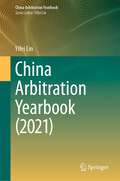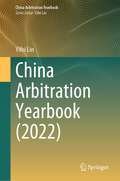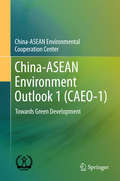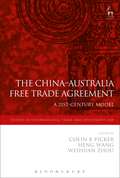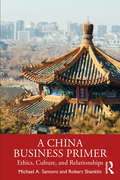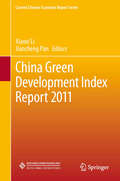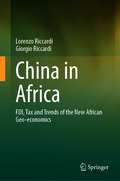- Table View
- List View
China and International Law: The Boundary Disputes
by Byron N. TzouThis is the first volume to systematically look at how China uses international law to deal with its complex boundary questions--it borders on twelve countries. The book includes an examination of boundary claims, border policies, settlements, alignments, and armed conflicts. The author draws a clear picture of China's attitude toward the use of traditional law. He supports his study with treaties, historical background, maps, and legal arguments. The reader walks away with a fine understanding of China's behavior in negotiations and armed conflicts, the country's policy, and its philosophy on dispute settlement.China and International Law uses original sources to examine China's basic border policy. Chapters include: International Law; Border Policy; Boundary Disputes and Settlements; Unequal Boundary Treaties; Boundary Treaties; Determinants of Boundaries; and Methods for Settling Boundary Questions.
China and the International Astronomical Union: Divorce, Separation and Reconciliation (1958–1982) (Historical & Cultural Astronomy)
by Thierry Montmerle Yi ZhouSeen from “inside the IAU,” this book tells the in-depth story of a major crisis in which China “divorced” from the International Astronomical Union in 1960 as a protest against the admission of Taiwan. This happened to all the scientific unions at the same time, and to the Olympic Games, which, unexpectedly, would serve as a laboratory for the “reconciliation” which took place following the re-opening of China to the world 20 years later.The so-called “China conflict” is the most important crisis in the post-WWII history of the IAU. Yet, many details about this conflict and its links to broader geopolitical events have long remained unsettled, obscure, or altogether absent. In particular, the book describes for the first time the “separation” period, which covered the Cultural Revolution, and in which the IAU made desperate official efforts to reach out to China, while some groups of Western and Chinese astronomers managed to keep contact at times. On the occasion of the IAU Centenary celebrations in 2019, the book revisits this painful succession of events using unpublished documents from the IAU Archives and the International Council of Scientific Unions. The book also contains supplementary typescripts of selected handwritten correspondences and the full translation of key original Chinese documents unknown to readers outside China.What emerges is a complex and fascinating story of human relations and science diplomacy under the shadow of the Cold War. Readers will learn how the 20-year “China conflict” as lived by astronomers and scientists is important not only for the history of the IAU, but also for the history of contemporary China. “This book is full of so many original documents of the IAU office, very reliable and good to open to the public readers.” Shuhua Ye, Shanghai Observatory (IAU Vice-President, 1988-1994)This book is a companion book to "Astronomers as Diplomats," published at the same time in the same series.
China and the International Criminal Court (Governing China in the 21st Century)
by Dan ZhuThis book focuses on the evolving relationship between China and the International Criminal Court (ICC). It examines the substantive issues that have restricted China’s engagement with the ICC to date, and provides a comprehensive assessment of whether these Chinese concerns still constitute a significant impediment to China’s accession to the ICC in the years to come. The book places the China-ICC relationship within the wider context of China’s interactions with international judicial bodies, and uses the ICC as an example to reflect China’s engagement with international institutions and global governance in general. It seeks to offer a thought-provoking resource to international law and international relations scholars, legal practitioners, government legal advisers, and policy-makers about the nature, scope, and consequences of the relationship between China and the ICC, as well as its impact on both global governance and order. This book is the first of its kind to explore China’s engagement with the ICC primarily from a legal perspective.
China and the WTO: A Long March towards the Rule of Law
by Esther LamJoining the World Trade Organization (WTO) enables China to reform its legal order and to move towards a system incorporating major principles of the rule of law. The WTO also serves as an external impetus that guides contemporary Chinese legal reform and orients it in ways that domestic forces alone could not achieve and sustain. Much discussion on the WTO and the Chinese legal system has focused on the issue of compliance ― whether the Chinese legal system has the capacity to fulfill China’s WTO accession commitments. The focus of this work is less concerned with compliance issues per se, but rather with the extent to which the WTO’s requirements vis-à-vis China actually affect the Chinese legal system. The fine difference between the two approaches lies in the fact that efforts by the Chinese government to meet its WTO obligations necessarily impact the Chinese legal order and its way of functioning, even if their end results may or may not lead to full compliance with what is required of it by the WTO. This timely work exposes many behind-the-scene dealings and relies on valuable information that is not publicly available. Not only does it preserve for the historical record important details of the Chinese WTO accession, it also sheds light on the travaux préparatoires of China’s accession agreement and the negotiation history of important issues, some of which remain relevant and highly contentious today. As expressed by WTO Director-General Pascal Lamy in his foreword to the book, ‘through this work, Esther Lam succeeds in demonstrating how WTO membership can benefit both the acceding country and the wider WTO family of nations.’
China and the WTO: Why Multilateralism Still Matters
by Petros C. Mavroidis Professor Andre SapirAn examination of China’s participation in the World Trade Organization, the conflicts it has caused, and how WTO reforms could ease them China’s accession to the World Trade Organization (WTO) in 2001 was rightly hailed as a huge step forward in international cooperation. However, China’s participation in the WTO has been anything but smooth, with China alienating some of its trading partners, particularly the United States. The mismatch between the WTO framework and China’s economic model has undermined the WTO’s ability to mitigate tensions arising from China’s size and rapid growth. What has to change? China and the WTO demonstrates that unilateral pressure, by the United States and others, is not the answer. Instead, Petros Mavroidis and André Sapir show that if the WTO enacts judicious reforms, it could induce China’s cooperation, leading to a renewed confidence in the WTO system.The WTO and its predecessor, the General Agreement on Tariffs and Trade, are predicated on liberal domestic policies. They managed the previous accessions of socialist countries and big trading nations, but none were as large or powerful as China. Mavroidis and Sapir contend that for the WTO to function smoothly and accommodate China’s unique geopolitical position, it needs to translate some of its implicit principles into explicit treaty language. To make their point, they focus on two core complaints—that Chinese state-owned enterprises (SOEs) benefit from unfair trade advantages, and that domestic companies, private as well as SOEs, impose forced technology transfer on foreign companies as a condition for accessing the Chinese market—and they lay out specific proposals for WTO reforms.In an age of global trade disputes, China and the WTO offers a timely exploration of unprecedented challenges to the current multilateral system and fresh ideas for lasting solutions.
China and the WTO: Why Multilateralism Still Matters
by Petros C. Mavroidis Professor Andre SapirAn examination of China’s participation in the World Trade Organization, the conflicts it has caused, and how WTO reforms could ease them China’s accession to the World Trade Organization (WTO) in 2001 was rightly hailed as a huge step forward in international cooperation. However, China’s participation in the WTO has been anything but smooth, with China alienating some of its trading partners, particularly the United States. The mismatch between the WTO framework and China’s economic model has undermined the WTO’s ability to mitigate tensions arising from China’s size and rapid growth. What has to change? China and the WTO demonstrates that unilateral pressure, by the United States and others, is not the answer. Instead, Petros Mavroidis and André Sapir show that if the WTO enacts judicious reforms, it could induce China’s cooperation, leading to a renewed confidence in the WTO system.The WTO and its predecessor, the General Agreement on Tariffs and Trade, are predicated on liberal domestic policies. They managed the previous accessions of socialist countries and big trading nations, but none were as large or powerful as China. Mavroidis and Sapir contend that for the WTO to function smoothly and accommodate China’s unique geopolitical position, it needs to translate some of its implicit principles into explicit treaty language. To make their point, they focus on two core complaints—that Chinese state-owned enterprises (SOEs) benefit from unfair trade advantages, and that domestic companies, private as well as SOEs, impose forced technology transfer on foreign companies as a condition for accessing the Chinese market—and they lay out specific proposals for WTO reforms.In an age of global trade disputes, China and the WTO offers a timely exploration of unprecedented challenges to the current multilateral system and fresh ideas for lasting solutions.
China Arbitration Yearbook (China Arbitration Yearbook)
by Yifei LinThis book presents a selection of the latest arbitration cases, materials, and commentaries from China. It aims to provide information on the theory and practice of arbitration combined. It is intended to provide readers with a useful resource to guide them when they encounter actual China-related arbitration cases. This book is a valuable resource for all practitioners concerned with international and foreign-related arbitration matters in China, global law firms, companies engaged in multinational business, jurists, and academics.
China Arbitration Yearbook (China Arbitration Yearbook)
by Yifei LinThis book presents a selection of the latest arbitration cases, materials, and commentaries from China. It aims to provide information on the theory and practice of arbitration combined. It is intended to provide readers with a useful resource to guide them when they encounter actual China-related arbitration cases. This book is a valuable resource for all practitioners concerned with international and foreign-related arbitration matters in China, global law firms, companies engaged in multinational business, jurists, and academics.
China-ASEAN Environment Outlook 1 (CAEO-1): Towards Green Development
by China-ASEAN Environmental CooperationThis book presents a comprehensive analysis of the status and progress of China-ASEAN green development and examines the common development issues in China and ASEAN Member States (AMSs). It also explores development trends within the framework of global and regional environmental governance and discusses the approaches towards green development in China and AMSs, offering its own definition of green development and using a “pressure-state-response” (PSR) model to build a framework for assessing green development. The book includes typical policy measures and numerous practices for green development in China and AMSs in the form of tables, figures and boxes. Based on detailed analysis, it argues that the global 2030 Agenda for Sustainable Development brings significant opportunities to China and AMSs, that the ongoing pragmatic cooperation should be further advanced, and that a connection between the Belt and Road Initiative and green ASEAN Community should be established to achieve regional sustainable development. As such it furthers readers’ understanding of environment and development and practical policy advice for promoting China-ASEAN cooperation on environment and green development. Intended for decision makers from the government, business sector, and civil societies who are working to boost green development and China-ASEAN cooperation, it is also a valuable resource for government officials, researchers and non-experts interested in creating a balanced relationship between the environment and development.
The China-Australia Free Trade Agreement: A 21st-Century Model (Studies in International Trade and Investment Law)
by Colin Picker Heng Wang Weihuan ZhouThis book provides readers with a unique opportunity to learn about one of the new regional trade agreements (RTAs), the China–Australia Free Trade Agreement (ChAFTA), that has been operational since December 2015 and is now at the forefront of the field. This new agreement reflects many of the modern and up-to-date approaches within the international economic legal order that must now exist within a very different environment than that of the late eighties and early nineties, when the World Trade Organization (WTO) was created. The book, therefore, explores many new features that were not present when the WTO or early RTAs were negotiated. It provides insights and lessons about new and important trade issues for the twenty-first century, such as the latest approaches to the regulation of investment, twenty-first century services and the emerging digital/knowledge economy. In addition, this book provides new understandings of the latest RTA approaches of China and Australia. The book's contributors, all foremost experts on their subject matter within this field, explore the inclusion of many traditional trade and investment agreement features in the ChAFTA, showing their continuing relevance in modern contexts.
The China-Australia Free Trade Agreement: A 21st-Century Model (Studies in International Trade and Investment Law #18)
by Colin Picker Heng Wang Weihuan ZhouThis book provides readers with a unique opportunity to learn about one of the new regional trade agreements (RTAs), the China–Australia Free Trade Agreement (ChAFTA), that has been operational since December 2015 and is now at the forefront of the field. This new agreement reflects many of the modern and up-to-date approaches within the international economic legal order that must now exist within a very different environment than that of the late eighties and early nineties, when the World Trade Organization (WTO) was created. The book, therefore, explores many new features that were not present when the WTO or early RTAs were negotiated. It provides insights and lessons about new and important trade issues for the twenty-first century, such as the latest approaches to the regulation of investment, twenty-first century services and the emerging digital/knowledge economy. In addition, this book provides new understandings of the latest RTA approaches of China and Australia. The book's contributors, all foremost experts on their subject matter within this field, explore the inclusion of many traditional trade and investment agreement features in the ChAFTA, showing their continuing relevance in modern contexts.
China: Bioethics, Trust, and the Challenge of the Market (Philosophy and Medicine #96)
by J. Tao Lai Po-Wahto the Moral Challenges H. Tristram Engelhardt, Jr. and Aaron E. Hinkley 1 Taking Finitude Seriously in a Chinese Cultural Context Across the world, health care policy is a moral and political challenge. Few want to die young or to suffer, yet not all the money in the world can deliver physical immortality or a life free of suffering. In addition, health care needs differ. As a result, unless a state coercively forbids those with the desire and means to buy better basic health care to do so, access to medicine will be unequal. No co- try can afford to provide all with the best of care. In countries such as China, there are in addition stark regional differences in the quality and availability of health care, posing additional challenges to public policy-making. Further, in China as elsewhere, the desire to lower morbidity and mortality risks has led to ever more resources being invested in health care. When such investment is supported primarily by funds derived from taxation, an increasing burden is placed on a country’s economy. This is particularly the case as in China with its one-child policy, where the proportion of the elderly population consuming health care is rising. Thesepolicychallengesarecompoundedbymoraldiversity. Defacto,humansdo not share one morality. Instead, they rank cardinal human goods and right-making conditions in different orders, often not sharing an af?rmation of the same goods or views of the right.
A China Business Primer: Ethics, Culture, and Relationships
by Michael A. Santoro Robert ShanklinThe COVID-19 pandemic underscored longstanding fissures in China’s business relationships with the West. If the West is going to develop a relationship of mutual trust and improve business relations with China in the coming decades, it is imperative to understand how to engage with Chinese thinking on ethics in business—this book explains how. Government officials, businesspeople, and business-ethicists have trouble communicating about issues in ethics, policy, and business across the China-West divide. This book shows how to overcome the us-versus-them mindset plaguing China-West relations by presenting to Western audiences an easy-to-understand yet deeply informed primer on core ideas and perspectives in Chinese cultural and philosophical thought. The book considers original texts of Chinese philosophy and religion, and applies principles from those writings to three business-ethics topics of enduring interest to business executives, government officials, and academics, namely, the protection of intellectual property, assurance of product safety and quality in the pharmaceutical supply chain, and human rights. This book is a must-read for those who want to forge constructive relationships with their Chinese counterparts based on mutual trust and understanding. The book is specifically relevant to business executives, but it should also be of interest to policymakers, educators, and students who seek to communicate more effectively with their Chinese counterparts, in particular about difficult and contentious business, policy, and ethical issues.
A China Business Primer: Ethics, Culture, and Relationships
by Michael A. Santoro Robert ShanklinThe COVID-19 pandemic underscored longstanding fissures in China’s business relationships with the West. If the West is going to develop a relationship of mutual trust and improve business relations with China in the coming decades, it is imperative to understand how to engage with Chinese thinking on ethics in business—this book explains how. Government officials, businesspeople, and business-ethicists have trouble communicating about issues in ethics, policy, and business across the China-West divide. This book shows how to overcome the us-versus-them mindset plaguing China-West relations by presenting to Western audiences an easy-to-understand yet deeply informed primer on core ideas and perspectives in Chinese cultural and philosophical thought. The book considers original texts of Chinese philosophy and religion, and applies principles from those writings to three business-ethics topics of enduring interest to business executives, government officials, and academics, namely, the protection of intellectual property, assurance of product safety and quality in the pharmaceutical supply chain, and human rights. This book is a must-read for those who want to forge constructive relationships with their Chinese counterparts based on mutual trust and understanding. The book is specifically relevant to business executives, but it should also be of interest to policymakers, educators, and students who seek to communicate more effectively with their Chinese counterparts, in particular about difficult and contentious business, policy, and ethical issues.
China Court Cases on Intellectual Property Rights: Update and Commentary Version
by Zhou LinThis book presents, in extraordinary detail, sixteen landmark cases that profoundly affect the protection of intellectual property rights in China. Written by six prominent Chinese legal scholars and jurists – including judges who themselves participated in these decisions – each case is fully described and analysed: the parties and their representatives, the basic facts, the facts ascertained by the court, the evidence presented by plaintiffs and defendants, the judges’ opinions with their arguments and reasoning, the unanimous conclusions, and the judgment, along with a wealth of deeply informed comment. Among the questions raised by these cases are the following: Is a website within the definition of a ‘work’ in copyright law, and thus protected? How should the acts of uploading and downloading of works from the Internet be classified? Can the concept of torts be applied in the Internet context? What is the legal liability of an Internet service provider? How is a defendant’s ‘unreasonable conduct’ to be determined? Who is responsible for the determination of ‘artistic value’ – e.g., of clothing designs? What evidence must be presented to serve as sufficient proof that a domain name is a party’s own creation? In what a manner should packaging and decoration be regarded? How should the ‘author’ in copyright conflict cases be identified? How should an unauthorized web link be judged? When do separate components assembled to create a product enjoy copyright protection? How should damages be determined? An introductory essay provides a detailed overview of the characteristics of China’s intellectual property law as it continues to develop, with attention to such factors as the specific laws enacted, the various courts and tribunals to which IP cases are assigned, the progress of a case, starting from filing to winding up, regulations, reform programs, and rules of evidence. The editor puts forward his own proposals – particularly in light of the so-called ‘interfering factors’ – on reform of civil trial style in intellectual property cases. It is difficult to overstate the value of this book to anyone involved in business dealings in China. With its authoritative expertise, abundant detail, and thorough elucidation of the salient features of developing IP law and practice in China, it will serve interested parties for years to come.
China, Cultural Heritage, and International Law (Routledge Research in International Law)
by Hui ZhongChina is a country that is rich in antiquities, but it is also a victim of looting that occurred during the period from the First Opium War to the end of the Japanese Occupation (1840–1945) when innumerable cultural objects were lost overseas. The Chinese Government insists on asserting its interest over its wrongfully removed cultural heritage and has sought for the return of lost cultural heritage by all means in accordance with relevant international conventions and Chinese laws. However, securing the return has been, and continues to be, problematic. Little research has been done regarding the question as to whether China has a legal basis for recovery, which is the first legal hurdle that China needs to get over. In addition, China does not have a legal basis for all cultural heritage taken during the period of 1840–1945. Claims for return without a legal basis are usually silenced or, at best, discussed only but very rarely facilitated. This book provides an answer for the return of Chinese cultural heritage. It examines the law contemporaneous to the removal of Chinese cultural heritage and its application. For this lack of a legal basis, this book argues that a new customary international law is emerging, according to which the interests of the states of origin in their wrongfully removed heritage should be prioritised. This proposed customary rule supports the return of wrongfully removed heritage. Once this proposed customary rule is accepted, it will provide a stronger argument not only for China, but also for other states of origin with a similar dilemma, including South Korea, Egypt, Greece, Cambodia, Turkey, Peru, and Italy, to recover their wrongfully removed heritage. While dealing with a large pool of return cases, this book is valuable to museums and art collectors in the event of buying and accepting art objects, and settling recovery disputes with states of origin. It will also be of interest to researchers, academics, policymakers, and students in the fields of cultural heritage law, international law, international trade, and human rights law.
China, Cultural Heritage, and International Law (Routledge Research in International Law)
by Hui ZhongChina is a country that is rich in antiquities, but it is also a victim of looting that occurred during the period from the First Opium War to the end of the Japanese Occupation (1840–1945) when innumerable cultural objects were lost overseas. The Chinese Government insists on asserting its interest over its wrongfully removed cultural heritage and has sought for the return of lost cultural heritage by all means in accordance with relevant international conventions and Chinese laws. However, securing the return has been, and continues to be, problematic. Little research has been done regarding the question as to whether China has a legal basis for recovery, which is the first legal hurdle that China needs to get over. In addition, China does not have a legal basis for all cultural heritage taken during the period of 1840–1945. Claims for return without a legal basis are usually silenced or, at best, discussed only but very rarely facilitated. This book provides an answer for the return of Chinese cultural heritage. It examines the law contemporaneous to the removal of Chinese cultural heritage and its application. For this lack of a legal basis, this book argues that a new customary international law is emerging, according to which the interests of the states of origin in their wrongfully removed heritage should be prioritised. This proposed customary rule supports the return of wrongfully removed heritage. Once this proposed customary rule is accepted, it will provide a stronger argument not only for China, but also for other states of origin with a similar dilemma, including South Korea, Egypt, Greece, Cambodia, Turkey, Peru, and Italy, to recover their wrongfully removed heritage. While dealing with a large pool of return cases, this book is valuable to museums and art collectors in the event of buying and accepting art objects, and settling recovery disputes with states of origin. It will also be of interest to researchers, academics, policymakers, and students in the fields of cultural heritage law, international law, international trade, and human rights law.
China-European Union Investment Relationships: Towards a New Leadership in Global Investment Governance?
The subject of investment relationships between the European Union and China is an increasingly vital topic to understand, yet academic literature has until now been underexplored. Bringing together expert contributors, this book provides a critical analysis of the current law and policy between the EU and China, which will prove to be vital in the field of international economic law. Divided into three parts, this book deals with the key issues of the EU-China investment partnership and its implications, both internally and internationally. Each chapter in China-European Union Investment Relationships covers a core theme of the subject of international economic law, including competition law, financial regulation, economic integration and dispute resolution. Covering the key topics in the area, and drawing diverse perspectives into a single collection, this book is an important resource for scholars and practitioners in legal and policy fields, and will be invaluable for students of trade and investment law to understand in more detail human rights and environmental law and policy.
China Food and Drug Law: Policy, Practice, and Future Directions (Law for Professionals)
by John C. BalzanoThis book is an analysis of policy and law governing the development, approval, manufacture, distribution, marketing and post-market surveillance of human drugs, medical devices, foods and cosmetics in Mainland China (“China FDD Regulation”). It analyzes the policy and general principles behind China FDD Regulation, including the history and jurisdiction of the central and local agencies that administer the laws and regulations, the administrative law structure in which these agencies operate, and other aspects of FDD Regulation interpretation and enforcement. Although it describes practice in China, this book is written in the comparative perspective (i.e., sensitive to assumptions made by those who are steeped in FDD Regulation in the U.S., Japan, and the EU). It includes one chapter on each regulatory space (drugs, medical devices, cosmetics, and food) organized by the lifecycle of products. It also covers subcategories of products, such as vaccines, radiopharmaceuticals, and in vitro diagnostic medical devices. The book includes specialty chapters on areas that are common to multiple types of regulated products, such as biosecurity and advertising. It is the first English language book of its kind, and it can serve as a resource for those in the FDD law and regulatory field to understand the mechanics of developing and marketing products, but also with insights for businesspeople and others, who are developing China-strategies.
China Green Development Index Report 2011 (Current Chinese Economic Report Series)
by Xiaoxi Li and Jiancheng PanWith the rapid growth of global industrialization, there has been substantial consumption of fossil fuels such as coal, petroleum, and natural gas along with growing carbon dioxide emissions. Unprecedented environmental and ecological crisis clouded the world. Fortunately, the Climate Conference in Copenhagen signaled hope amid the sluggish global economic recovery. Countries worldwide have been braced for developing their scientific and industrial strategies in the era of post financial crisis with a green and low-carbon philosophy. In 2008, the UN unveiled a plan for green politics and green economy, which is well-received and carried out by countries worldwide. China’s 30-year rapid economic development has attracted worldwide attention. However, how to develop in a sustainable manner when faced with acute contradictions between economic growth, resources and environment has posed great challenges to China. Therefore, it is of great significance for us to speed up the study of green development and find a rational growth model. This study is completed by Prof. Li Xiaoxi and the dedication of other leading thinkers in economics, management, environment and resources together with the help of China Economic Monitoring and Analysis Center (CEMA).
China Green Development Index Report 2012: Regional Comparison (Current Chinese Economic Report Series)
by Xiaoxi Li Jiancheng PanThe report was launched during China’s Twelfth Five-year Period (2011-2015). After revising the measurement system of the Green Development Index 2011, the report measures the green development level of 30 provinces, municipalities and autonomous regions as well as 38 large and medium-sized cities in China. A Public Satisfaction Survey of the Urban Residents is first introduced into the report. Both the province and the city Green Development Index systems consist of three parts, the green degree of economic growth, the carrying potential of natural resources and environment, and the support degree of government policies. The three parts reflect the production and resource usage efficiency, the situation of environment and resources protection and pollutants emission, and government’s related investment and management respectively. The China Green Development Index Report 2012 has the comprehensive evaluation of the green economy development in China and its importance to China’s rational development and switch in economic development model.
China in Africa: FDI, Tax and Trends of the New African Geo-economics
by Lorenzo Riccardi Giorgio RiccardiThis book highlights China’s engagement with Africa through trade, investment and financial linkages. Its three main goals are as follows: firstly, to provide insights into Chinese FDI in Africa, by exploring a range of infrastructural projects and several countries’ historical, geographical, socio-political, cultural and economic backgrounds; secondly, to present the main double taxation treaties with Beijing and country profiles of the African economies; and lastly, to provide a valuable business guide for recognizing and capitalizing on new opportunities in Afro-Eurasia.
China Rule of Law and the West
by Michael HooperThis book reveals how the Chinese Party-State uses "ideo-political education" to inculcate young citizens with official narratives on law. It provides an account of China's version of "rule of law" under the Yifa Zhiguo paradigm, arguing that authorities see law as a tool to apply when convenient and ignore when it impedes Party-State goals. Moving beyond the question of whether China's system can count as a rule of law order, this book identifies three consistent features of Chinese law reform since the Opening and Reform era began: the supremacy of the Communist Party of China over the law, instrumentalism, and reform-repression dualism. This book uniquely combines the "what" with the "how" of China's "rule of law" efforts. China law researchers will benefit from understanding how China's young adults learn about official law narratives. A more general audience interested in China's legal and political system will gain valuable insights from the analysis of China's "rule of law." The growing tensions between China and the West mean that now, more than ever, scholars and policymakers need to properly understand China. Understanding what Chinese officials mean when they talk about the rule of law in China helps avoid policy errors made from mistakenly assuming that Western definitions are universal. The contents of this book can also inform government and university efforts to properly accommodate Chinese students in the West while mitigating harmful manifestations of the nationalist ideology, in part implanted by ideo-political education.
China, the EU and International Investment Law: Reforming Investor-State Dispute Settlement (The Rule of Law in China and Comparative Perspectives)
by Yuwen Li Tong Qi Cheng BianThis book provides an original and critical analysis of the most contentious subjects being negotiated in the China–EU Comprehensive Agreement on Investment (CAI). It focuses on the pathway of reforming investor-state dispute settlement (ISDS) from both Chinese and European perspectives in the context of the China–EU CAI and beyond. The book is divided into three parts. Part I examines key and controversial issues of the China–EU CAI negotiations, including market access, sustainable development and human rights, as well as comparing distinct features between the China–EU CAI and the China–US BIT. Part II concentrates on the institutional reform of investor-state arbitration with an extensive analysis of the EU’s approach to replacing the private nature of investment arbitration with the public nature of an investment court. Part III addresses the core substantive and procedural issues concerning ISDS, such as the role of domestic courts in investment dispute settlement, the status of state-owned enterprises (SOEs) as investors, transparency and the protection of victims in investment dispute resolution. This book will be of interest to scholars and practitioners in the field of international investment and trade law, particularly investment dispute settlement.
China, the EU and International Investment Law: Reforming Investor-State Dispute Settlement (The Rule of Law in China and Comparative Perspectives)
by Yuwen Li Tong Qi Cheng BianThis book provides an original and critical analysis of the most contentious subjects being negotiated in the China–EU Comprehensive Agreement on Investment (CAI). It focuses on the pathway of reforming investor-state dispute settlement (ISDS) from both Chinese and European perspectives in the context of the China–EU CAI and beyond. The book is divided into three parts. Part I examines key and controversial issues of the China–EU CAI negotiations, including market access, sustainable development and human rights, as well as comparing distinct features between the China–EU CAI and the China–US BIT. Part II concentrates on the institutional reform of investor-state arbitration with an extensive analysis of the EU’s approach to replacing the private nature of investment arbitration with the public nature of an investment court. Part III addresses the core substantive and procedural issues concerning ISDS, such as the role of domestic courts in investment dispute settlement, the status of state-owned enterprises (SOEs) as investors, transparency and the protection of victims in investment dispute resolution. This book will be of interest to scholars and practitioners in the field of international investment and trade law, particularly investment dispute settlement.





